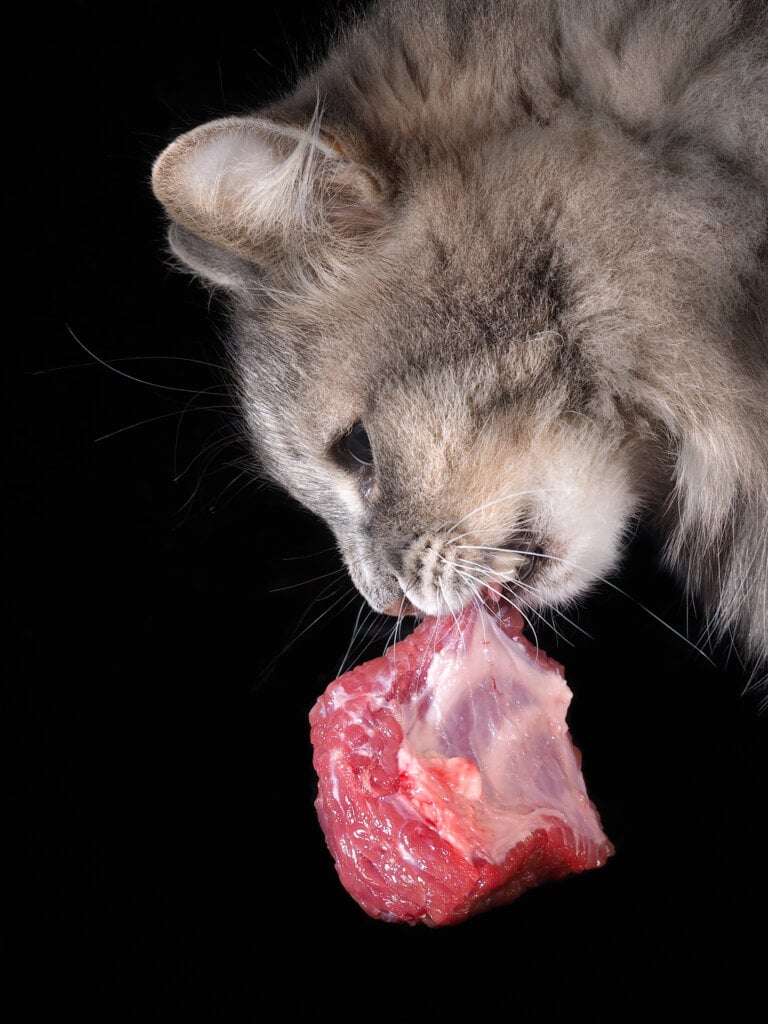Remember to feed your kitten twice a day – once with dry food and once with wet food.
To ensure the best nutrition for your kitten, we recommend starting with either Hill’s Science Diet Sensitive Stomach or Stella and Chewy kitten food,
pâtés and canned foods should be avoided. Kittens are often not used to these types of food, and introducing them too soon can lead to digestive issues such as vomiting, diarrhea, and other health concern.
Many of our breeders feed their kittens a raw meat diet and meat mixes, which is why we strongly recommend offering raw meat for at least the first two weeks after bringing your kitten home.
This will help your kitten adjust more quickly to the new environment. Even if they experience stress or digestive issues due to the transition, raw meat can gently restore their stomach and encourage them to eat the food they are accustomed to.
Providing familiar nutrition during this crucial period ensures a smoother adaptation and a healthier start in their new home. 🐾❤️Before feeding raw, it should be frozen for 7–10 days at -18°C (0°F) or lower to eliminate any potential parasites and ensure it’s safe to eat.
What Meat Can You Give Your Kitten?
✔ Chicken – breast, thigh, gizzards, hearts.
✔ Turkey – breast, thigh, hearts.
✔ Beef – small amounts of lean cuts.
✔ Rabbit – lean meat, organs.
✔ Duck – breast, thigh, hearts.
✔ Quail – whole or boneless meat.
How to Prepare the Meat?
Divide the meat into small portions, pack it into ziplock bags, and freeze for 7–10 days. You can also use pre-frozen meat from the store if it has been kept frozen for an extended period.
Moving to a new home is a big stress for a kitten, and in the first 1–2 weeks, they may refuse even their usual food. Their eating habits can temporarily change.
If your kitten is not eating at all:
With patience and care, your kitten will adjust and start eating with a healthy appetite again!
Make sure to add probiotics to wet food during the first week.
Probiotics can help safeguard the kitten’s digestive system and reduce the risk of any digestive problems arising from the transition to a new food and adjustment period.
After 2 weeks, you can gradually introduce premium dry food brands such as Origen, Acana, or Tiki Cat. Start by mixing these brands with the Hills or Royal Canin dry food in a half-and-half ratio.
Over time, you can slowly transition your kitten to solely eating one of the premium brand dry and wet foods or raw meat. This will ensure they receive the highest quality nutrition.

Do you want to feed your cat the best natural food without the hassle of preparing and freezing raw meat? We have the perfect alternative – ready-made raw meat meals enriched with essential vitamins and minerals.
These balanced and nutritious options provide everything your cat needs for optimal health, without the extra effort of handling raw meat yourself.
You can choose from the following brands:
🐾 Darwins (click for the website)
🐾 VIVA (click for the website)
🐾 Smalls(Click for the website)
Frozen raw meals are convenient, safe, and healthy – simply thaw and serve!
If you’re still unsure whether you’ve selected the best food for your kitten, we recommend visiting the independent website CatFoodDB.com.
There, you can search for specific brands and analyze their ingredients, nutritional value, and overall quality. This resource provides unbiased reviews and detailed breakdowns to help you make the most informed decision for your pet’s health.
Give your kitten the best start in life by choosing the right nutrition! 🐾❤️

We strongly encourage you to explore the inclusion of raw meat in your cat’s diet. Raw meat offers numerous health benefits to felines. I recommend watching a video by the renowned cat expert, Jackson Galaxy, as it can provide valuable insights into the advantages of incorporating raw meat into your cat’s diet.
The most straightforward approach is to prepare diced chicken meat, gizzards, and chicken thighs ( or any other type of raw meat that is good for cats) in small portions, as illustrated in the image. You can pre-assemble a month’s worth of supplies in advance. It’s crucial to freeze the meat for more than 10 days to ensure the elimination of all viruses and parasites. Following that, simply thaw a packet when it’s time for dinner.
We do not advise exclusively feeding your cat raw meat, as this can lead to bone-related issues. If you still opt for transitioning your cat to a raw meat diet, remember to include specialized vitamin supplements for such diets.
We recommend the following feeding regimen: Dry food once a day + Raw meat or Wet Food once a day. Typically, we suggest alternating between raw meat and wet food, whichever is more convenient for you.

Ensure your home is prepared to welcome your new furry companion. Examine the plants in your house for any toxicity concerns, as some, like lilies and aloe vera, can be harmful to your pets.
Additionally, make sure your home is furnished with cat-scratching posts.
The more scratching posts you provide, the less likely it is that your new friend will choose your cherished couch as a scratching surface. And even if they do develop a fondness for your sofa, with patience and training, they will eventually learn to use the scratching posts exclusively, preserving your bond with them.
Many kittens may not require cat houses, and at times, the ones you buy might remain unused. Most frequently, kittens prefer staying close to humans, and our couch often serves as their preferred resting place. Consequently, there may be no urgent need to invest in a separate cat house or bed. Nonetheless, a cat window hammock could prove to be a worthwhile addition. If you do decide to invest in a cat house, we suggest opting for a practical and durable wooden one. Many contemporary cat houses are upholstered in fabric and may wear out over time. The longevity of such houses typically does not exceed a year. Hence, it’s wise to always consider the long-term perspective.
Which type of litter box is suitable for your cat? With a cover or without? High sides or low? The choice depends on your kitten’s breed. If you have the largest domestic cat breed, such as the Maine Coon, your cat will require a litter box with very high walls and ample space. For owners of Munchkins or medium-sized breeds like the British or Scottish, a standard litter box with medium-height walls should work well. It’s worth noting that kittens often prefer uncovered litter boxes as they may not be accustomed to enclosed ones.
As for the type of litter, we recommend starting with straightforward options and avoiding experimentation initially. Allow your kitten to acclimate to their new home, and only consider changing the litter type after two weeks.Start with Wood or clumping cat litter.


Oko Cat is an excellent wood-based cat litter with elongated pellets, making it easy to maintain cleanliness. Starting from the second week, you have the option to purchase Tofu cat litter on Amazon, which has proven to be a game-changer for many of our cat owners. It`s low-tracking cat litter, which makes it a top choice for cat litter.One of the newest cat litter that is good for large breeds- is Purina Breeze.
Once your kitten arrives, you may find it necessary to give them a bath, especially if they belong to a long-haired breed. Long-haired kittens can become soiled during transportation and may benefit from a proper cleaning routine. All kittens require some level of fur care, but long-haired cats, in particular, demand extra attention to prevent their fur from tangling and forming mats.
In the long term, all cats, regardless of hair length, require regular brushing to minimize shedding throughout your home.
For long-haired cats, it’s essential to use specific tools likelonghair combs. These combs may have teeth of varying lengths or natural bristle brushes designed to maintain the coat’s appearance and remove loose hairs. Deshedding tools and slicker brushes are not suitable for long-haired breeds as they can irritate the skin, pull out fine hairs, cause discomfort, and damage the hair structure.
Shorthair cats have a different coat type, characterized by a dense and loose topcoat with a well-developed undercoat of the same length as the outer hair. To care for shorthair breeds, you should use a metal comb with medium-frequency teeth for the initial grooming stage. For the second stage, adeshedding tool can be used to manage the undercoat and eliminate excess hair. Finally, finish the grooming process with a massaging brush, which provides a gentle massage for the cat’s body and smooths the coat.
How often should you bathe your cat? 🐾
Cats are naturally very clean animals and usually do a wonderful job of grooming themselves. Forshort-haired cats, bathing is often not necessary at all—many live their whole lives without ever needing a bath, unless something unusual happens.
For long-haired breeds, the frequency depends on the owner’s preference and the cat’s lifestyle. Some choose a light bath every 2 months to make grooming easier and keep the coat silky, others prefer every 4–6 months, and for some, even once a year is perfectly enough.
The most important thing is not the strict schedule, but ensuring bath time is gentle, stress-free, and filled with care. With warm water, a mild cat shampoo, and plenty of love, your feline companion will stay comfortable, healthy, and happy.
Our kittens come equipped with a microchip, a small device that does not contain any information. To ensure that you can reunite with your kitten if you ever get separated, it’s essential to register the microchip along with your contact details in a dedicated database. You can locate the 15-digit number of your kitten’s microchip in their health certificate or passport.
By enrolling your pet’s information on FreePetChipRegistry.com, a trusted and no-cost animal identification database, you can enjoy peace of mind knowing that your pet’s home contact information is easily accessible. This service remains completely free throughout your pet’s lifetime and is available to anyone, regardless of the microchip brand they use. There are no registration or maintenance fees, and updating your contact information is also free of charge.
The microchip contains a unique ID number that links to your contact information, securely stored in the microchip company’s database.





